
|
Chemistry |
C18 |
|
Separation Mode |
Reversed Phase |
|
Particle Substrate |
Silica |
|
pH Range Min |
1 pH |
|
pH Range Max |
8 pH |
|
Maximum Pressure |
18000 psi (1240 Bar) |
|
Endcapped |
Yes |
|
Silanol Activity |
Low |
|
Particle Shape |
Spherical |
|
Particle Size |
2.5 µm |
|
Endfitting Type |
Parker-style |
|
Pore Size |
100 Å |
|
Format |
Column |
|
Surface Area |
230 |
|
System |
UPLC, UHPLC |
|
Particle Technology |
HSS |
|
USP Classification |
L1 |
|
Inner Diameter |
3 mm |
|
Length |
150 mm |
|
Carbon Load |
15 % |
|
eCord |
Yes |
|
UNSPSC |
41115709 |
|
Brand |
XSelect |
|
Product Type |
Columns |
|
Units per Package |
1 pk |

XSelect HSS C18 XP Column, 100Å, 2.5 µm, 3 mm X 150 mm, 1/pk
Created for the widest range of chromatographic separations, the Waters XSelect family of columns addresses the increasing complexity of samples and the need for more sorbents to provide diverse analyte selectivity. With this in mind, the XSelect HSS C18 XP Column combines multiple technologies to create a general-purpose, high-performance column that offers exception retention and peak shape across all compounds.
High Strength Silica (HSS) Technology is meant to complement the more hydrophobic BEH particle’s chromatographic performance, offering significant advantages such as increased polar compound retention and different selectivity. The HSS particle is also synthesized to possess the mechanical strength needed to tolerate UPLC pressures, giving it both reproducibility and transferability.
The XSelect HSS C18 XP Column is also part of the eXtended Performance column line, allowing for enhanced transition strategies between HPLC and UPLC technologies. Because it is compatible with any LC system, an XP column has additional flexibility for UPLC HPLC, and UHPLC users to improve productivity at intermediate backpressures. This enables exceptional separation performance, robustness, and throughput for HPLC assays while enabling seamless transition paths towards the adoption of UPLC.
All XSelect HSS columns and similar lab equipment are manufactured beginning with ultrapure reagents that control the chemical composition and purity of the final product. The process occurs in a cGMP, ISO 9001:200 certified plant where each step is conducted within narrow tolerances. Each column is tested individually and includes a Certificate of Bath Analysis and a Performance Chromatogram. Reversed-Phase QC Reference Material can be used to perform further testing in laboratories.
What Solvents Should I Use With XSelect HSS C18 XP Columns?
To ensure maximum column performance is maintained, high-quality chromatography grade solvents should be used. All aqueous buffers should be filtered prior to use; the addition of at least 5% organic to buffers is recommended in order to discourage bacterial growth. Waters recommends the use of Acrodisc filters. Solvents containing suspended particulate matter will usually clog the outside surface of the inlet frit of the column, resulting in higher operating pressure and poorer performance. All solvents should be degassed prior to use in order to prevent the formation of bubbles in the pump and detector. The use of an on-line degassing unit is recommended.